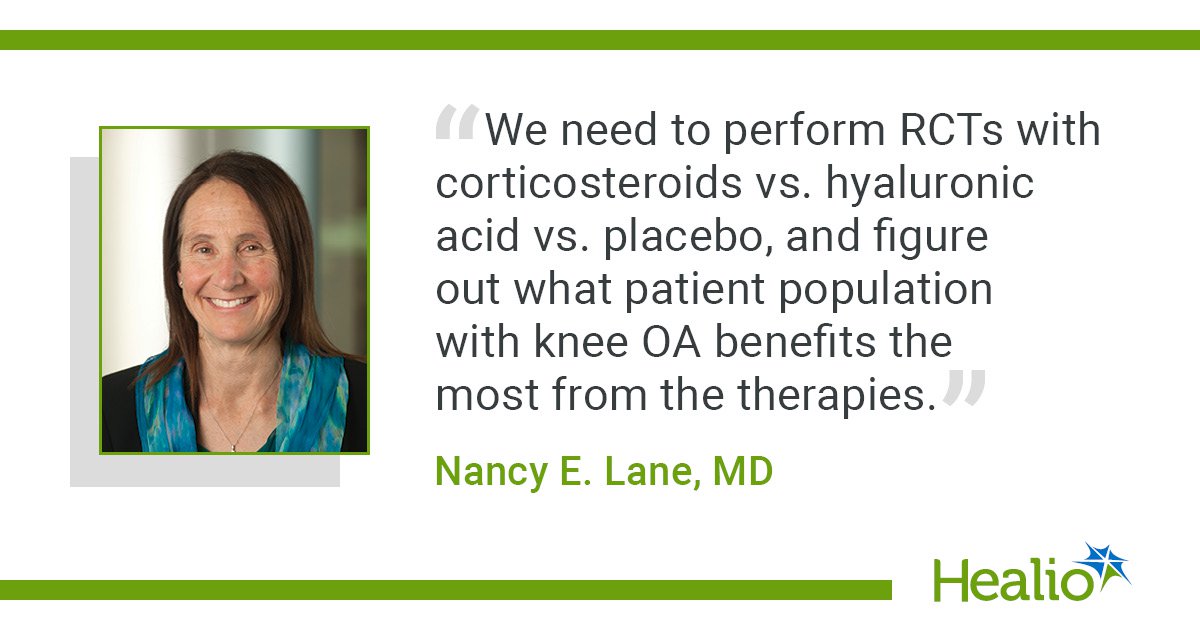August 08, 2025
4 min read
Key takeaways:
- A corticosteroid injection was associated with more knee OA disease progression vs. hyaluronic acid.
- Retrospective findings require further validation.
Patients who received a corticosteroid injection for knee osteoarthritis demonstrated more disease progression than those who received hyaluronic acid, according to findings published in Radiology.
The researchers used epidemiologic data from the Osteoarthritis Initiative (OAI), a multicenter, longitudinal, prospective study that stretched from February 2004 to January 2015, to assess the association between corticosteroid or hyaluronic acid infection and knee OA progression.

“We have known for quite a while that corticosteroid injections, especially more than one and more than once a year, have been associated with progression of knee OA,” Nancy E. Lane, MD, endowed professor of medicine, rheumatology and aging research in the University of California, Davis Health System, and one of the researchers of the study, told Healio. “This study adds to the growing literature. However, the issue is somewhat more complex.
“Patients that need multiple corticosteroid injections over a short period of time generally have more severe disease with synovitis and are generally at high risk for progression,” she added. “It is hard to have a good comparator group as those subjects with moderate-to-severe OA who do not undergo a corticosteroid injection may not have as much inflammation.”
In their analysis, Lane and colleagues examined data from 70 patients who underwent one corticosteroid or hyaluronic acid knee injection in, and had MRI information available in the period before, at the time of and 2 years following the procedure. In all, 44 patients received corticosteroid injections, while 26 received hyaluronic acid. Outcomes in the overall injection group were compared with those for 140 patients with comparable knee OA disease characteristics who had not received an injection. The primary outcome was knee joint tissue changes as assessed by whole-organ MRI score (WORMS),
According to the researchers, patients who received corticosteroids demonstrated greater disease progression compared with both the control (group mean difference, 0.39; 95% CI, 0.05-0.75 ) and hyaluronic acid (0.42; 95% CI, 0.01-0.84) groups.
Moreover, a decrease in WORMS scores for knee joint tissue degeneration was observed in the hyaluronic acid group vs. the injection-concurrent time frame (mean difference, 0.42; 95% CI –1.34 to 0.28). Further results showed that WOMAC pain decreased in both the corticosteroid and hyaluronic acid arms.
Healio sat down with Lane, who is also a member of the Healio Rheumatology Peer Perspective Board, to discuss the strengths and limitations of this particular data set, the outcome measures used to assess OA disease progression, and what these findings mean for patients going forward.
Healio: How does the longitudinal nature of the OAI impact how rheumatologists should interpret these results?
Lane: The MRI data in our recent study does show more change within the knee joint in corticosteroid-treated patients, however the data are derived from a longitudinal cohort of subjects, the OAI, and the study subjects were not examined frequently by a physician or other health care provider. Also, the physical activity and joint pain were only obtained annually by questionnaire.
If this study and others were performed as a clinical study, with more frequent physician visits, we would be more certain of these results.
The OAI is not a randomized controlled trial — it is epidemiologic data from a cohort. We need to perform RCTs with corticosteroids vs. hyaluronic acid vs. placebo, and figure out what patient population with knee OA benefits the most from the therapies.
Healio: Can you comment on the use of WORMS to assess these patients? Does this provide new or better information about how treatments are impacting the joint or how the disease is progressing?
Lane: WORMS is just like MOAKS (MRI Osteoarthritis knee score). It is semi-quantitative assessments of joint damage. It is validated and sensitive enough to detect change. WORMS comes out of the University of California, San Francisco, while MOAKS came from Boston University radiologist Ali Guermazi, MD, PhD, MSc. They are very similar and reasonably sensitive enough to predict change.
Healio: Do you still see a benefit to corticosteroid injections in OA?
Lane: Overall, physicians who treat patients with painful knee OA know that corticosteroid injections can reduce pain. If a patient asks for another one within a year of the initial injection, it identifies a patient who is likely to be having progression of the knee OA.
To determine if the joint destruction is from the steroid or the increased activity that results from a corticosteroid reduction in knee joint pain requires an RCT against a placebo or hyaluronic acid.
Healio: Do you have hope that RCT data will point to hyaluronic acid as a more viable steroid-sparing agent, or is the jury still out?
Lane: Hard to answer. In my experience, hyaluronic acid works pretty well in older individuals — patients in their 80s — with painful knee OA. However, in younger patients, or more active patients, I do not see much of an effect.
Remember, cartilage generates hyaluronic acid, the oil that makes the joint work. As we age, the joint makes less and we need more. It might be as good as corticosteroid injections but only in an older, less active group of subjects.
Healio: What else would you like to highlight about the results of this study?
Lane: Another issue about corticosteroid injections that may factor into these results is that they are frequently a crystalline formulation. After the injection, the crystals remain in the joint for a period of time. The crystals are believed to also contribute to the structural deterioration. Therefore, physicians that treat athletes and younger patients with OA try to use dexamethasone, a soluble non-crystalline formulation.
Although the analgesic and anti-inflammatory effects may be of shorter duration than crystalline corticosteroids, it is believed to not accelerate the tissue degeneration within the joints.
The other thing I would like to highlight is that a difference was detected in the MRI findings of joint degeneration between the corticosteroid and hyaluronic acid treatments. This is interesting. However, again, this is from a cohort, not a clinical study, therefore this needs to be re-examined in a randomized clinical trial to confirm or refute this observation.
Reference:
Bharadwaj UU, et al. Radiology. 2025;doi:10.1148/radiol.233081.
For more information:
Nancy E. Lane, MD, can be reached at nelane@ucdavis.edu.










